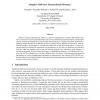Free Online Productivity Tools
i2Speak
i2Symbol
i2OCR
iTex2Img
iWeb2Print
iWeb2Shot
i2Type
iPdf2Split
iPdf2Merge
i2Bopomofo
i2Arabic
i2Style
i2Image
i2PDF
iLatex2Rtf
Sci2ools
WDAG
2005
Springer
2005
Springer
Adaptive Software Transactional Memory
Software Transactional Memory (STM) is a generic synchronization construct that enables automatic conversion of correct sequential objects into correct nonblocking concurrent objects. Recent STM systems, though significantly more practical than their predecessors, display inconsistent performance: differing design decisions cause different systems to perform best in different circumstances, often by dramatic margins. In this paper we consider four dimensions of the STM design space: (i) when concurrent objects are acquired by transactions for modification; (ii) how they are acquired; (iii) what they look like when not acquired; and (iv) the non-blocking semantics for transactions (lock-freedom vs. obstruction-freedom). In this 4-dimensional space we highlight the locations of two leading STM systems: the DSTM of Herlihy et al. and the OSTM of Fraser and Harris. Drawing motivation from the performance of a series of application benchmarks, we then present a new Adaptive STM (ASTM) sy...
| Added | 28 Jun 2010 |
| Updated | 28 Jun 2010 |
| Type | Conference |
| Year | 2005 |
| Where | WDAG |
| Authors | Virendra J. Marathe, William N. Scherer III, Michael L. Scott |
Comments (0)

